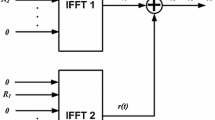Abstract
This paper proposes a new crest factor reduction scheme to reduce instantaneous-to-average power ratio (IAR) resulting decent peak reduction, and adjacent channel leakage ratio (ACLR) reduction, though the error vector magnitude (EVM) is significantly enhanced. In the conventional peak cancellation (CPC) technique, peak regrowth occurs as a result of finite impulse response (FIR) filter windows overlapping. The peak regrowth problem in CPC technique can be compensated, though this will lead to increased computational complexity and degradation in EVM. The proposed algorithm allocates spacing to contiguous peaks to avoid FIR filter windows overlapping. Two types of overlapping are discussed, incremental and decremental. The optimum spacing can be determined from the FIR filter impulse response characteristic. Simulations are carried out with different intra-band non-contiguous carrier aggregated OFDM signals. The results of simulations show between 3 and 10% improvement in EVM performance while maintaining equivalent IAR and ACLR performance. Applying the proposed optimum spacing peak cancellation scheme compared to the conventional peak cancellation technique.



















Similar content being viewed by others
References
GPP TR 36.804 v0.7.1. (2007–2010). 3rd generation partnership project; technical specification group radio access network; evolved universal terrestrial radio access (E-UTRA); base station (BS) radio transmission and reception (release 8) (p. 185).
Rumney, M. (2013). LTE and the evolution to 4G wireless. Hoboken: Wiley.
Armstrong, J. (2001). New OFDM peak-to-average power ratio reduction scheme. In IEEE 53rd vehicular technology conference (pp. 756–760).
Olli, O. V., Vankka, J., & Halonen, K. (2002). Effect of clipping in wideband CDMA system and simple algorithm for peak windowing (pp. 614–619). San Francisco: World Wireless Congress.
Kim, W. J., Cho, K. J., Stapleton, S. P., & Kim, J. H. (2007). Doherty feed-forward amplifier performance using a novel crest factor reduction technique. IEEE Microwave and Wireless Components Letter,17(1), 82–84.
Richard, V. N., & Prasad, R. (1999). OFDM for wireless multimedia communications. Norwood, MA: Artech House.
Ku, S. J. (2014). Low-complexity PTS-based schemes for PAPR reduction in SFBC MIMO–OFDM systems. IEEE Transactions on Broadcasting,60(4), 650–658.
Yang, L., Soo, K. K., Siu, Y. M., & Li, S. Q. (2008). A low complexity selected mapping scheme by use of time domain sequence superposition technique for PAPR reduction in OFDM system. IEEE Transactions on Broadcasting,54(4), 821–824.
Feng, G. (2015). Method and apparatus for crest factor reduction. U.S. Patent 0349994 A1.
Jeon, H. B., No, J. S., & Shin, D. J. (2012). A new PAPR reduction scheme using efficient peak cancellation for OFDM systems. IEEE Transactions on Broadcasting,58(4), 619–628.
Yang, Z., Gandhi, H., Ding, I., & Jorgensen, L. (2013). Crest factor reduction for dual-band systems. In IEEE MTT-S International Microwave Symposium Digest (IMS). https://doi.org/10.1109/mwsym.2013.6697564.
Fehri, B., Boumaiza, S., & Sich, E. (2014). Crest factor reduction of inter-band multi-standard carrier aggregated signals. IEEE Transactions on Microwave Theory and Techniques,62(12), 3286–3297.
Oppenheim, A. V., Schafer, R. W., & Buck, J. R. (1999). Discrete-time signal processing. Upper Saddle River, N.J: Prentice Hall.
Song, J., & Ochiai, H. (2016). Performance analysis for OFDM signals with peak cancellation. IEEE Transactions on Communications,64(1), 261–270.
Huang, W. J., Hu, W. W., Li, C. P., & Chen, J. C. (2015). Novel metric-based PAPR reduction schemes for MC-CDMA systems. IEEE Transactions on Vehicular Technology,64(9), 3982–3989.
Bahai, A. R. S., Singh, M., Goldsmith, A. J., & Saltzberg, B. R. (2002). A new approach for evaluating clipping distortion in multicarrier systems. IEEE Journal on Selected Areas in Communications,20(5), 1037–1046.
Upton, G., & Cook, I. (2008). A dictionary of statistics. Oxford: OUP Oxford.
Liu, Q., Ma, X., Zhou, G.T., & Jie, W. (2008). Peak-to-average power ratio versus instantaneous-to-average power ratio for OFDM. In 42nd asilomar conference on signals, systems and computers (pp. 938–942).
Hemphill, Ed., Summerfield, S., Wang, G., & Hawke, D. (2007). Peak cancellation crest factor reduction reference design, application note, Xilinx.
Acknowledgements
This publication has emanated from research conducted with the financial support of Science Foundation Ireland (SFI) and is co-funded under the European Regional Development Fund under Grant Number 13/RC/2077. Pooria Varahram, Somayeh Mohammady, Ronan Farrell and John Dooley are with the Department of Electronic Engineering, National University of Ireland Maynooth (NUIM).
Author information
Authors and Affiliations
Corresponding author
Additional information
Publisher's Note
Springer Nature remains neutral with regard to jurisdictional claims in published maps and institutional affiliations.
Rights and permissions
About this article
Cite this article
Varahram, P., Mohammady, S., Farrell, R. et al. A Crest Factor Reduction Scheme with Optimum Spacing Peak Cancellation for Intra-band Non-contiguous Carrier Aggregated OFDM Signals. Wireless Pers Commun 112, 651–673 (2020). https://doi.org/10.1007/s11277-020-07066-y
Published:
Issue Date:
DOI: https://doi.org/10.1007/s11277-020-07066-y




